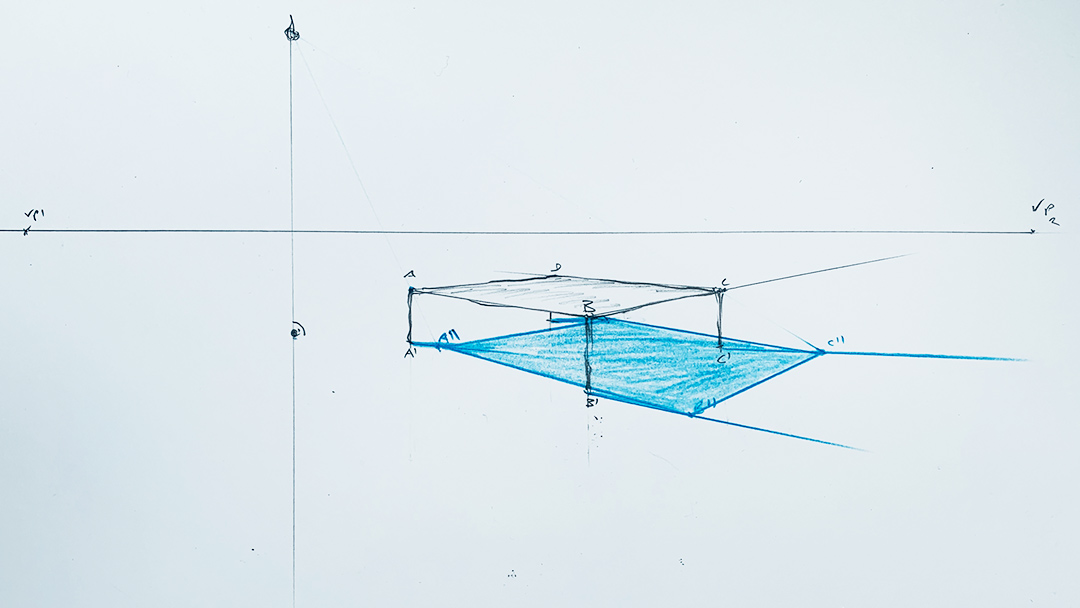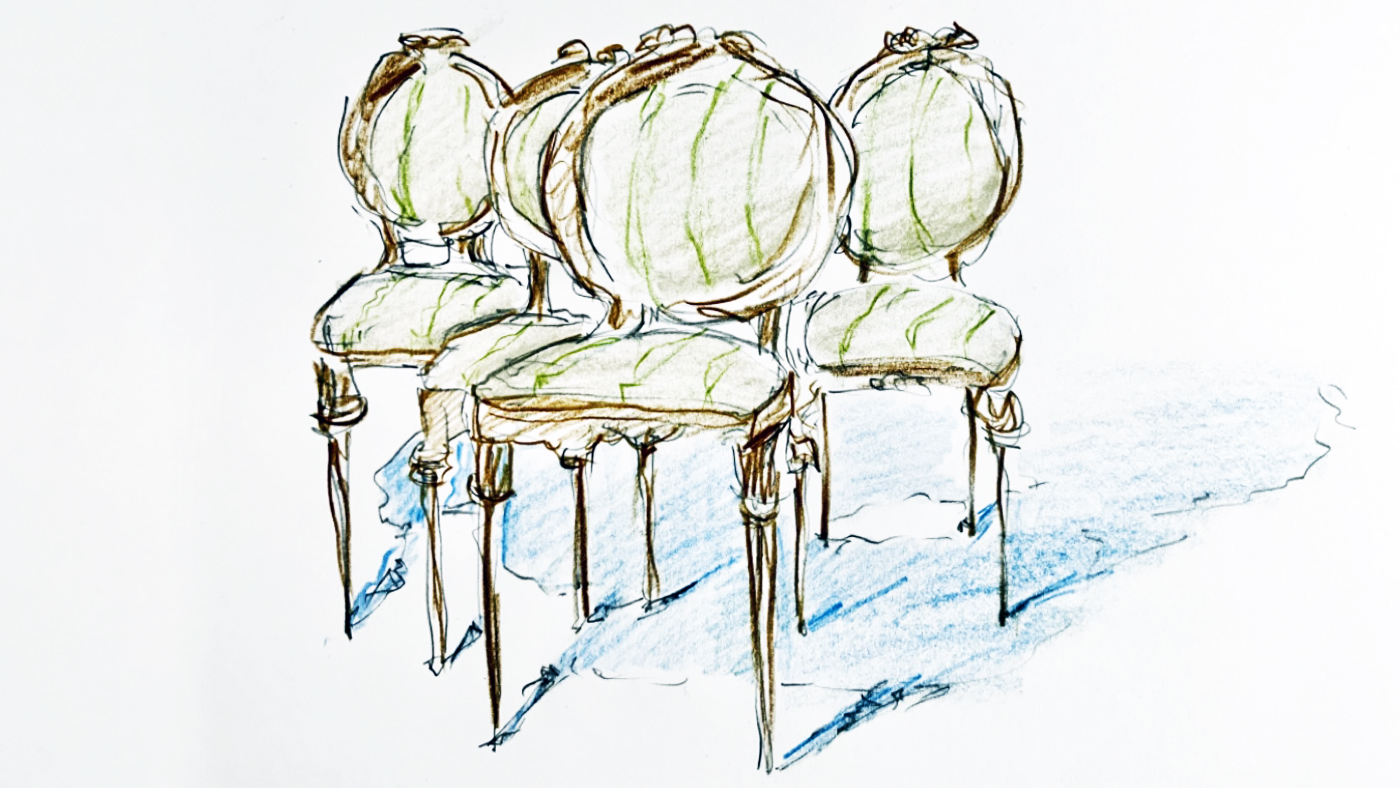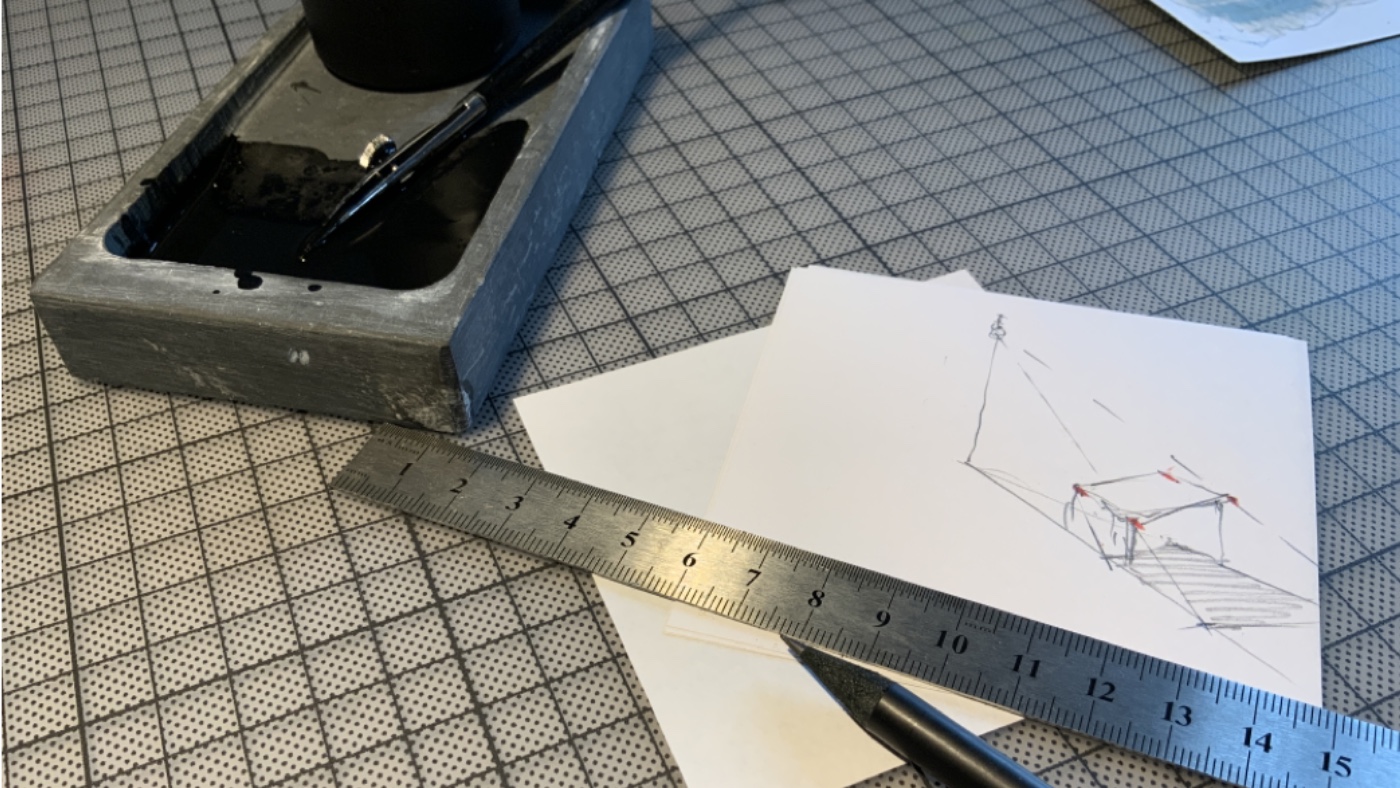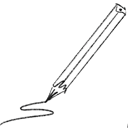Rule 10 | Set cast shadows
Lesson 3 | Cast shadows from artificial light well
45 min.
The construction of cast shadows is an efficient tool to make a scene more intense. Because the light well can be set to work with more or fewer contrasts.
Step 1 | Watch, see and understand the basic system.
Learn how the system of cast shadows work with artificial light.
More or less it is the same principle. The only difference is that you find the foot point of the light directly under the lamp. Sometimes it is not so easy to find it if you have a few reference points.
Script
Hello, happy sketching. I’m drawing a table under an artificial light well. And we will construct the cast shadow. I show you how.
(00:13)
I start with the horizon like we always do. Horizon, straight line … called horizon. With a vanishing point here and a vanishing point here. And now I’m starting to construct a table that is in the middle of the page. I do this with the two vanishing points. I’m starting from here, drawing a line from here to here. And the same for the other edge of the table. Drawing a line from this point to the vanishing point. Then I do the other edge of the table somewhere here, to the vanishing point and the other edge of the table. The surface of the table from here.
Okay, this is the surface of my table. I sketch it a little bit so you can see it better. This is the surface of the table with the corners A-B-C and D. Now I am constructing the legs of the table. The vertical always stay vertical. Meaning I have all vertical lines for the legs. This is a little bit hidden. And the fourth leg, the length of the leg, I do adjust really, maybe something like this. Meaning if this leg is long like this, this leg will be long like this. This gives me the length of the other leg because these lines are parallel. This is parallel as well. And the fourth leg goes to the left vanishing point once again. Meaning, oh, this is short. It’s a little bit hidden, but those are the four legs.
(02:37)
I get rid of the lines that I do not use, actually. Okay, this is something like my table. I sketch it a little bit freehand. This is always what I do when I construct something. I can just highlight the line a little bit and then you see it better. Okay, this is my table. I do not use this as a construction line. Okay, now I take a color blue for the shadow and actually, no, first. Sorry. Now I add the light.
(03:25)
Well, here it is. This is my bulb’s artificial light. Well, and it needs a foot point like the sun. So vertically down to somewhere. It should be somewhere on the carpet, naturally. So I just admit it is here. This is my foot point of the light. This will be important for the direction of the shadows because this foot point is kind of a vanishing point of the light. Well. Okay, now I’m starting with this foot point. And I tear all the lines going to the vanishing points or the other way around. They are fleeing from the vanishing point, meaning that the shadow of leg B goes in this direction. The shadow of leg C has a link to the footpoint of the light well. So it means it goes in this direction. And the same for the leg A and the same for leg D. Meaning all those shadows start from the footpoint of the table. So of the leg A of the table here, of the leg B, of the table here, of the leg C of the Table. They are all going to vanish away from the footpoint of the Light because this is kind of a perspective. Now, what we can do actually we can do the same for the edges of the table. So edge A has a shadow somewhere, must be on the other shadow here of the leg. So on the top of the leg somewhere here. But where? Actually, this is very easy. You can draw a line from the light well over. So going from here over A to the Leg, meaning this is the corner A and the same you can do here.
Over the edge of corner B goes the light down. This will be our image of corner B. We can do the same with corner C from the light well here over corner C. So from here over corner C down to the shadow till it crosses. And the last one we do for corner D, it will be a little bit hidden, I think. Well, from here over corner D down to where it intersects with the shadow. Okay, the easiest one to see actually is the distance between A and B here where is this shadow? So meaning between B, oh, I forgot this here, and C here. So this is not parallel by the way, because all is perspective. We are in a free space. But here you can see this is the edge of BC. So I want to construct the edge for A to B, and A to B. I connect those points A to B. The third thing, D and C. So point D is somewhere here, it intersects here and C is here. So I go from D to C and from A here to D here it is here.
(07:29)
Okay, now this is the shadow of the table. I colour it a little bit so that you understand it more easily.
Okay, I repeat the point A is cast by the light well down to the floor somewhere. To be sure where we are on the floor, we have the footpoint connected with the foot point of the table’s leg. And this is the shadow of this length here. The same I did with the corner b down here. So here it’s a little close, a little bit close, but you can find it out.
It’s like this, the same I did with the Corner C light well C cast it down to the floor, and the same foot point of the line cars it over the foot point of the table here. The intersection gives this point and so on and so forth. So what is your task? You have to understand this concept because you have to freely construct cast shadows. So please make the same drawing as help for further drawings.
For further understanding of this problem. Or you can make a film with your mobile phone that helps you, later on, to understand this more easily again. And you can upload your sketch as usual happy sketching.


ASSIGNMENT | Draw yourself a memory help or make a short film tutorial
Upload the sketch of the cast shadow construction.
To upload use the buttons further down.

Free trial
Try one lesson and decide if you want to do the whole course. Click for the free trial ...
Certificate
If you want to achieve a certificate that proves your sketching skills, get all your information here ...


